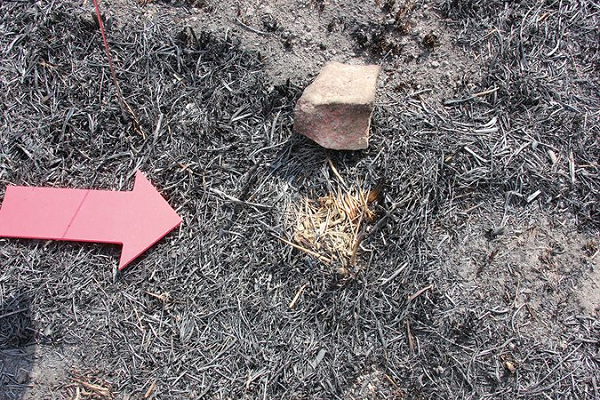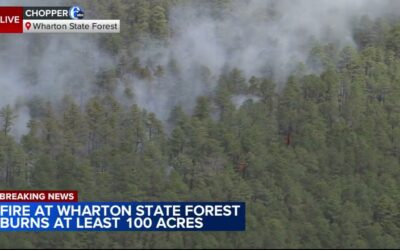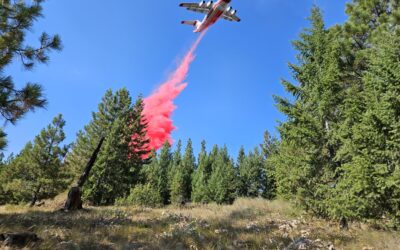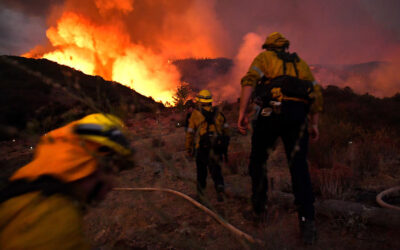Challenging criticisms from the NFPA

The field is the laboratory of the NWCG methodology; it’s a part of the study of the real world and the real world of science. (Photo by Keith Cullom/www.fire-image.com.)
Division between the NWCG Wildland Fire Investigation Subcommittee and some members of the NFPA Fire Investigation Technical Committee leads to confusion
By Alan Carlson | FireRescue Magazine Volume 13, Issue 4
“It’s time to rein in those wildland fire renegades.” Those were the words of Dr. Vytenis Babrauskas at the May 2, 2017, meeting of the National Fire Protection Association (NFPA) Fire Investigation Technical Committee, words that signified the end of a long cooperative working relationship between that committee and the National Wildfire Coordinating Group (NWCG) Wildland Fire Investigation Subcommittee (WFISC). As I would later find out, this was because of a power play by a special interest group within, and associated with, Technical Committee members interested in branding their own yet to be created wildland fire investigation methodology in an effort to compete with the NWCG methodology. That power play has now been transformed into a campaign to attack the NWCG and its tested and proven wildland fire investigation methodology.
Enforce Compliance?
When someone makes a call to “rein in the wildland fire renegades,” the question that should be asked first is, by what authority do they claim to be the ones who “rein in” anyone as part of their mission? Let’s look at the mission of the NFPA Fire Investigation Technical Committee.
“NFPA 921, Guide for Fire and Explosion Investigations, was developed by the Technical Committee on Fire Investigations to assist in improving the fire investigation process and the quality of information on fires resulting from that process. The goal of the committee is to provide guidance to both public and private investigators based on accepted scientific principles and scientific research.”1
I see no reference to an authority to “rein in” others in this statement from NFPA 921.
The NFPA itself weighs in on this subject in every standard and guide it publishes. The following, taken from the 2017 version of NFPA 921, clearly establishes that principle. “The NFPA has no power, nor does it undertake, to police or enforce compliance with the contents of NFPA Standards.” (NFPA 921-17, inside front cover)
The fact is, no matter how hard some members of the NFPA Fire Investigation Technical Committee try to convince others, they have neither the role nor the authority “to police or enforce.” And that includes reining in anyone. The direction the Technical Committee is currently headed will only serve to create confusion and divisiveness within the field of wildland fire investigation.
Criticisms
Let’s look at the criticisms that Dr. Babrauskas has leveled against the wildland fire community in his letter to the editor, published in the August 2017 edition of Fire Engineering. In his letter to the editor, Dr. Babrauskas expressed three opinions, which in summary are:
1. “The NWCG, on the other hand, even though it just published the third edition (2016) of its Guide, remains committed only to a systematic method and has not been able to accept the scientific method or the need to make the wildfire investigation specialty a science-based profession.”2
2. “It is alarming for the members of the NFPA 921 committee to note that the 337-page NWCG Guide contains a grand total of seven technical references—actually, only six, since one is a duplicate. Of these references, not even one has been published in a peer-reviewed journal.” (2)
3. “We find this situation unacceptable. Fire investigators who investigate wildland fires must come to recognize that to be credible, their work has to be based on the scientific method and that steps must be taken toward establishing the proper science base for wildland fire aspects of fire investigation.” (2)
Committee Background
Let’s start with a little background on the issues. Neither Dr. Babrauskas nor any member of the Technical Committee has ever approached NWCG with these issues. Instead, they are resorting to backroom politics, an attack campaign, and secrecy. While Dr. Babrauskas and the NFPA Fire Investigation Technical Committee members have been focused on structural fire investigation for many years, the NWCG WFISC (authors of the 2016 NWCG “Guide to Wildland Fire Origin and Cause Determination”) and its forerunners have spent more than 40 years improving the wildland fire investigation methodology, substantially longer than NFPA 921 or the NFPA Fire Investigation Technical Committee has existed.
During those 40-plus years, the focus for NWCG has been on the advancement of the methodology, terminology, research, and science of wildland fire investigation while the NFPA Fire Investigation Technical Committee has remained essentially silent and disassociated from the wildland community. No other group has been responsible for advancing the discipline more than the NWCG WFISC.
The NWCG WFISC has continued to develop and make available at little to no cost to the user the most complete publications and training programs on wildland fire investigation that exist today. (You can download a free electronic copy of the 2016 NWCG “Guide to Wildland Fire Origin and Cause Determination” from the NWCG Web site.) Used extensively both nationally and internationally, the NWCG materials are the basis for the NFPA 921 introduction to wildland fire investigation. (NFPA 921-17 Section 28.1.1.)
The 2011-2017 NFPA 921 chapters on wildland fire investigation were written by subject matter experts from the NWCG WFISC at the request of the Technical Committee because it lacked the expertise in the specific field/discipline. Throughout those editions, there has been only one correction and no challenges to the materials. During the NFPA revision for each edition, that material was peer reviewed through the NFPA revision process and found to be sound.
While the NWCG WFISC is made up entirely of wildland fire investigation subject matter experts, the Technical Committee has had, and continues to have, no “user group” representation on it in the form of any wildland fire investigation subject matter experts, a violation of American National Standards Institute requirements for a consensus document.

The NWCG methodology is not only peer reviewed, it is tested and proven over years of application by “experts in the appropriate field,” wildland fire investigators. (Photo by author.)
The past cooperation between the Technical Committee and the NWCG WFISC has been a successful and productive partnership that has benefited the wildland fire investigation community by keeping the methodology consistent between the NFPA and NWCG documents. It is a cooperative relationship that the NWCG WFISC offered to continue at the May 2, 2017, meeting of the NFPA Fire Investigation Technical Committee. That offer was rejected by a dominating faction within the Technical Committee in favor of branching off on its own under the cover of a so-called “scientific method” version for Chapter 28.
Challenging the Criticisms
So now that we have some background, let’s first address the criticisms by Dr. Babrauskas by defining what a methodology is. It has been defined as a set of methods, rules, or ideas that are important in a science or art, or as a set or system of methods, principles, and rules regulating a given discipline, as in the arts or sciences. As defined, a methodology is not singular, it is plural, a fact that Dr. Babrauskas and associates seem to overlook to focus solely on a singular approach to fire investigation, the scientific method alone.
Ask yourself this: When was the last time a person armed only with the knowledge of the scientific method determined a credible origin or cause for a fire? While Dr. Babrauskas well understands his “steps” to the scientific method, he knows nothing about the rules, ideas, and methods important in the science and art of wildland fire investigation. The truth is, there is no indication that he has ever conducted a wildland fire investigation. Nor does the special interest group associated with his efforts include a wildland fire investigation subject matter expert.
Now, let’s talk about Dr. Babrauskas’ statement that NWCG “remains committed only to a systematic method.” Ironically, NFPA 921 states, “The systematic approach recommended is based on the scientific method, which is used in the physical sciences.” (NFPA 921-17, 4.2) Apparently, under this description within NFPA 921, the NFPA remains committed only to a “systematic approach.” Dr. Babrauskas seems to stress the failure of the NWCG to use the scientific method (a recommended systematic approach) instead of just a systematic method, while at the same time NFPA 921 calls the scientific method its systematic approach.
Despite what Dr. Babrauskas would have readers believe, the NWCG WFISC has not rejected the scientific method or science. In fact, nothing could be further from the truth. If he had bothered to read the 2016 NWCG “Guide to Wildland Fire Origin and Cause Determination,” a publication he did not even provide the correct title for in his letter, he would have seen that the coverage of the scientific method has been expanded by 300 percent.
Problem Solving and Scientific Method
What seems on the surface to vex him and the small special interest group associated with a portion of the Technical Committee is that the NWCG WFISC believes that a “methodology” is made up of both a problem-solving process that is the scientific method and the “…practices, procedures, and techniques (methods)…” that are specific to the discipline of wildland fire investigation. Here is the official position from the 2016 NWCG “Guide to Wildland Fire Origin and Cause Determination,”3
“Methodology: A methodology is the systematic application (framework) of practices, procedures, and techniques (methods) common to the field of wildland fire investigation as applied to solve the problems of specific scene conditions and needs. It is a combination of two processes, a framework for problem solving, and the specific methods applied to gather data during a wildland fire investigation. The framework for problem solving within a systematic methodology discussed in this guide is the scientific method used in the physical sciences.”
It is clear for any reader to see that what Dr. Babrauskas has alleged is not consistent with the position of the NWCG WFISC or the “Guide.” While Dr. Babrauskas states that he finds it “deplorable,” I find it even more deplorable that he would not gather the empirical data before he concludes and attacks the entire international community of wildland fire investigators, calling them renegades. After all, collecting empirical data is an important part of the scientific method, is it not? And failing to gather or present all the relevant data is an important part of promoting confirmation bias.
The 2016 NWCG “Guide to Wildland Fire Origin and Cause Determination,” is, in fact, a peer-reviewed technical reference that is based on more than 40 years of corporate observations, experience, and research. Peer review is not inclusive of just peer-reviewed academic journals, as Dr. Babrauskas would selectively have you believe. Consider the definition of “peer review,” which is a process by which a scholarly work is checked by a group of experts in the appropriate field. The NWCG methodology is not only peer reviewed, it is tested and proven over years of application by “experts in the appropriate field,” wildland fire investigators.
NWCG Guide
The NWCG “Guide” is the place where observations, experiences, and research are reflected, peer reviewed, and proven. The NWCG “Guide” is tested and proven every time students or experienced investigators use the NWCG methodology to successfully locate items as small as a burnt paper match in the ignition area of a wildland fire, something that has been done countless times. It is also tested and proven during the tens of thousands of times that wildland fire investigators have observed actual wildland fire behavior, not in a laboratory, and not in some theoretical abstract universe. The field is the laboratory of the NWCG methodology; it’s a part of the study of the real world and the real world of science.
In his letter, Dr. Babrauskas also questions the reference materials in the NWCG “Guide” as deficient. That may be because it is the reference material, included for NFPA 921, Chapter 28. And it may be because the NWCG chooses to list such reference materials in a different format. For example, NFPA 921, Chapter 28 Wildfire Investigation (2011-2017), has only 12 referenced materials, and six of those are references to the peer-reviewed NWCG publications and training or reference materials authored by NWCG WFISC members. If Dr. Babrauskas is so appalled with the lack of referenced material in the NWCG Guide, why does his own publication, NFPA 921, rely on that same material to form half of its reference materials? In addition, if Dr. Babrauskas had gathered all the data before he formulated his opinions, or taken the time to have contacted anyone at NWCG before he published his opinions, he would have found that a much more extensive listing of reference materials for the 2016 NWCG “Guide to Wildland Fire Origin and Cause Determination” is posted on the NWCG WFISC Web site. This is to facilitate periodic updating and additions, an idea that the NFPA 921 Technical Committee may want to explore if it wants to keep up with the science of today. Dr. Babrauskas ignores this fact.
Battle Over Content
Dr. Babrauskas and a small special interest group are currently driving the revision of NFPA 921, Chapter 28, 2020. That small special interest group is on a campaign to discredit the NWCG and its tested and proven methodology. It is the same old NFPA 921 Technical Committee supremacy issue that has gone on for decades. It is currently on a campaign to express opinions unsupported by fact and is using the standard bat to beat the opposition with, claims that others do not follow the scientific method. While it is not true in this case, it hopes that the reader will take its word for it.
Dr. Babrauskas and the special interest group associated with the Technical Committee have abandoned the successful relationship with the NWCG Subcommittee and are determined to focus even more singularly on the scientific method by supplanting the scientific principles, practices, methods, etc., proven to work in the NWCG materials. They are in the process of overhauling the NFPA 921 chapter on wildland fire investigation for the 2020 edition to reflect structural fire investigation terminology, made up terminology, and a draft that reflects no practical methodology at all. None of it has been peer reviewed, tested, or proven. The real issue here is being disguised as a battle over the scientific method. It is not. The real issue is a battle over content.
So, who are the real “renegades”? Those who would promote a tested and proven methodology for wildland fire investigation or those who would throw that methodology out in favor of a yet to be brainstormed, untested, and unproven document with no methodology at all?
I would appeal to all interested parties to get all the facts before they depend on the claims and opinions of this special interest group. In the judicial system, such allegations are consistent with someone who cannot make a case on the facts. And I would suggest to the NFPA that it is time to clean house at the Fire Investigation Technical Committee and return to a true consensus process and document.
As a last note, I applaud Dr. Babrauskas’ efforts to encourage more federal funding for wildland fire investigation research. It is good to see that, after 40 years, members of the NFPA Fire Investigation Technical Committee have finally engaged and joined the historical efforts of the NWCG WFISC in supporting and obtaining additional research on the subject. Instead of just blaming others for a lack of research, I would encourage Dr. Babrauskas and the NFPA to step up and provide grant funding of their own to assist in that effort.
References
1. National Fire Protection Association, “NFPA 921, Guide for Fire and Explosion Investigations, 2017 edition, https://www.nfpa.org/codes-and-standards/all-codes-and-standards/list-of-codes-and-standards/detail?code=921.
2. Babrauskas, Vytenis, PhD, “Letter to the Editor,” Fire Engineering, August 2017.
3. National Wildfire Coordinating Group, “Guide to Wildland Fire Origin and Cause Determination,” April 2016, https://www.nwcg.gov/publications/412.
 Alan Carlson has been involved in the wildland fire community for more than 46 years, with much of that time focused on wildland fire investigation. He has been associated with the NWCG Wildland Fire Investigation Subcommittee for more than 13 years and served as the chair of that subcommittee for three years. He is a qualified INVF wildland fire investigator and an INTM-qualified major investigation team member as well as a class coordinator and instructor for both. Carlson has coauthored most of the NWCG wildland fire investigation publications and training courses and has made many national and international wildland fire investigation presentations.
Alan Carlson has been involved in the wildland fire community for more than 46 years, with much of that time focused on wildland fire investigation. He has been associated with the NWCG Wildland Fire Investigation Subcommittee for more than 13 years and served as the chair of that subcommittee for three years. He is a qualified INVF wildland fire investigator and an INTM-qualified major investigation team member as well as a class coordinator and instructor for both. Carlson has coauthored most of the NWCG wildland fire investigation publications and training courses and has made many national and international wildland fire investigation presentations.




